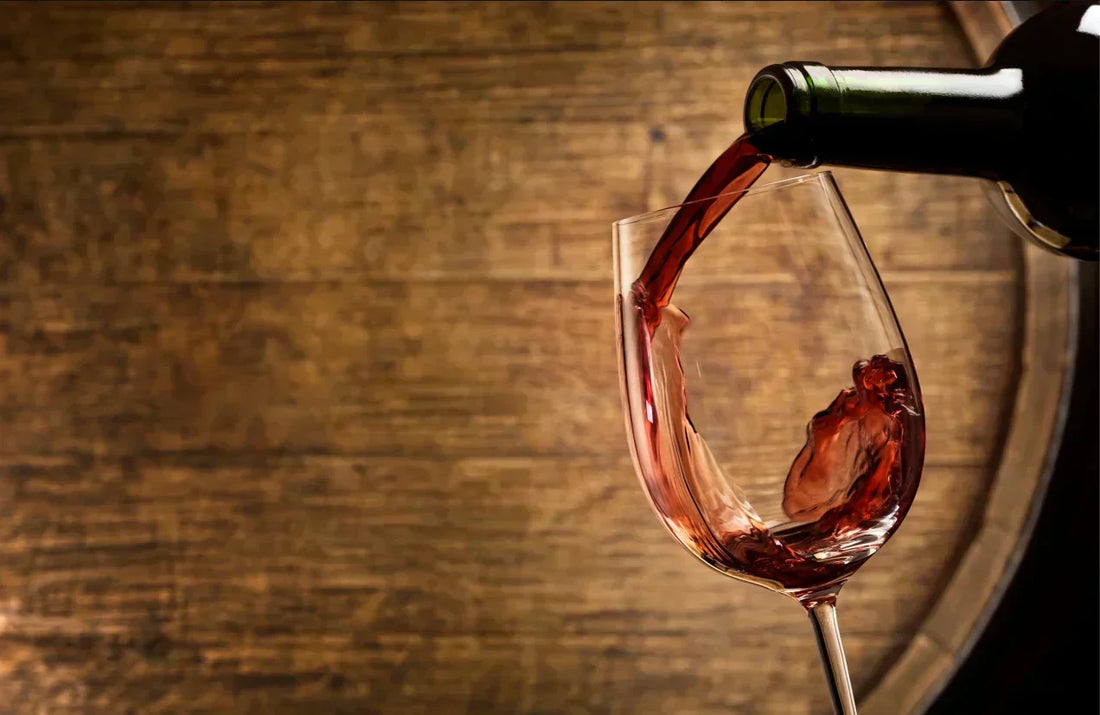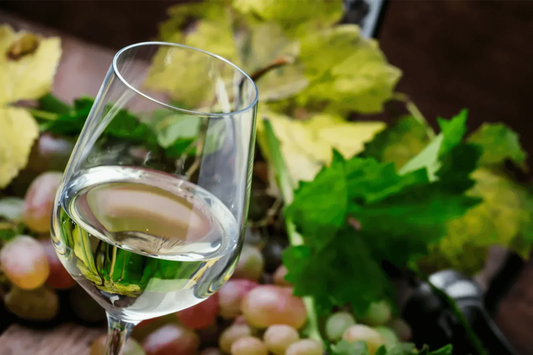
What Are Tannins in Wine?
Ever wondered why some red wines leave a dry, slightly bitter taste in your mouth? That feeling comes from tannins, an important component that affects the flavour, structure, and ageing ability of your favourite bottle. In this guide, we’ll explore what tannins are, how they influence red wine, and why getting to know them can enrich your wine journey.
What Are Tannins in Wine?
Tannins are natural compounds known as polyphenols, and they're found in many plants such as grapes, tea leaves, nuts, and even chocolate. In wine, tannins contribute to a dry, sometimes slightly bitter flavour that you can feel on your palate.
In short, Tannins are what give wine its structure, complexity, and ability to age gracefully.
Where Do Tannins in Wine Come From?
Tannins in wine mainly come from the skins, seeds, and stems of grapes, as well as from oak barrels used during the ageing process. For red wines, the juice stays in contact with the grape skins longer, which helps tannins to naturally infuse into the wine, giving red wines a richer tannic structure compared to white wines that usually have minimal skin contact. Additionally, ageing wine in oak barrels allows it to absorb extra tannins, adding more depth and character to the final taste.
Why Does Red Wine Have More Tannins
The phrase "tannins in red wine" often evokes a sense of structure and a pleasing mouthfeel. Unlike white and rosé wines, red wines stay in contact with their skins a bit longer, which naturally draws out more tannins and adds to their character. Varieties such as Cabernet Sauvignon, Syrah, Nebbiolo, and Tannat are especially known for their rich tannin content, making them fantastic options for anyone seeking a fuller, more vibrant wine experience.
Curious about which red wines stand out for their unique flavours and tannin profiles?
👉 Discover more in our guide: 15 Popular Red Wine Types Every Wine Lover Should Know and find your next favourite bottle!
How Tannins Affect the Taste and Texture of Wine
Tannins play a key role in your wine experience, adding unique flavours and textures that make each wine special. Here’s a little insight into how tannins influence what you taste and feel with every sip.
Astringency and Dryness
One of the most noticeable effects of tannins is the astringent, drying sensation they create on your tongue and gums. This happens because tannins bind with proteins in your saliva, causing that familiar puckering feeling, especially in young red wines.
Bitterness and Flavour Complexity
Tannins bring a gentle touch of bitterness that adds depth and complexity to the flavour of the wine. When it's well-balanced, this slight bitterness enriches the wine's richness and character, making each glass a more delightful and engaging experience.
Structure and Mouthfeel
Beyond just taste, tannins add a lovely backbone and structure to a wine, creating a firmer, more full-bodied mouthfeel. Wines with higher tannin levels tend to feel bolder and more substantial, making them perfect companions for hearty, flavourful foods.
Ageing Potential
Tannins also allow wine to age gracefully. As time goes on, they gently soften and meld together, giving the wine a development of flavours that become more elegant and harmonious. That's why tannic red wines often benefit from some extra patience in the cellar, becoming smoother and more refined as they mature.
How to Identify and Appreciate Tannins in Wine
Here are some practical steps to help you identify tannins in wine:
- Observe the colour: Deep, intense colour in red wine often signals a higher tannin content.
- Notice the astringency: Pay attention to the dry or puckering sensation on your tongue and gums after sipping. This is a classic sign of tannins at work.
- Consider the persistence: Wines with more tannins tend to leave a lingering, slightly grippy feeling in your mouth long after you swallow.
- Compare young and aged wines: Young wines typically have stronger, more pronounced tannins, whereas aged wines tend to be softer and more integrated.
- Practice with different varieties: Taste a range of wines, from high-tannin grapes like Cabernet Sauvignon and Nebbiolo to lower-tannin options, to better train your palate.
Factors That Influence Tannin Levels
The amount of tannin in your wine isn't just about the grape. It’s influenced by everything from the vineyard to the cellar. Knowing these factors can help you choose and enjoy wines that match your preferred tannin level.
1. Grape Variety
The type of grape used can affect the tannin level in a wine. For instance, red grapes with thicker skins, like Cabernet Sauvignon, Nebbiolo, and Tannat, are naturally richer in tannins. Meanwhile, varieties such as Pinot Noir and Gamay have thinner skins and tend to create wines that are softer and less tannic, making them very inviting.
Common high-tannin grape varieties:
- Cabernet Sauvignon
- Nebbiolo
- Tannat
- Sagrantino
- Syrah/Shiraz
- Malbec
- Petit Verdot
- Mourvèdre (Monastrell)
Common low-tannin grape varieties:
- Pinot Noir
- Gamay
- Grenache (Garnacha)
- Barbera
- Merlot (usually medium to low tannin)
2. Winemaking Techniques
The process of making wine can affect the amount of tannin it contains. For example, keeping the grape skins in contact during fermentation, including seeds and stems, and ageing in new oak barrels all tend to boost tannin levels. Usually, wines that stay longer on the skins will have a stronger tannic flavour. On the other hand, winemakers looking for a smoother taste might choose shorter skin contact or opt for older barrels.
3. Climate and Growing Conditions
The environment where grapes grow influences how tannins develop. Warmer climates usually lead to grapes that are riper and have softer, rounder tannins, making the wine feel more plush and inviting. On the other hand, cooler areas tend to produce wines with firmer, more astringent tannins, which can add structure and depth. Things like sunlight, rainfall, and soil type all play a part in shaping the final tannin profile, making each wine unique and special.
Best Food Pairings for Tannic Red Wines
Pairing tannic red wines with the right foods can elevate your dining experience. The astringency of tannins is nicely balanced by rich proteins and fats, making wines like Cabernet Sauvignon or Nebbiolo excellent choices for grilled meats, hearty stews, and aged cheeses. When you choose your pairings thoughtfully, the flavours of food and wine complement each other beautifully, turning your meal into a truly special and memorable occasion.
Want to learn more about the basics of wine and food pairing?
👉 Check out our in-depth guide: Wine Pairing 101: Simple Rules for Matching Wine and Food Perfectly.
Conclusion
Understanding tannins in wine opens up a world of richer flavours, delightful aromas, and more enjoyable tasting experiences. Whether you're curious about the science behind their presence or seeking practical tips on tasting and pairing, tannins play a vital role in the wine journey.
So go ahead- explore, taste, and savour the world of tannins. Your next favourite wine might be just a sip away!
FAQ
1. What are tannins in wine?
Tannins in wine are natural compounds called polyphenols, which are mainly found in the skins, seeds, and stems of grapes. They give red wines their distinct, dry, astringent character and play a key role in how the wine ages and develops over time.
2. Why do red wines have more tannins than white wines?
Red wines tend to have a higher tannin content because their juice stays in contact with the grape skins for longer during fermentation. This longer skin contact extracts more tannins, giving the wine a richer structure and a fuller mouthfeel compared to white or rosé wines, which have minimal skin contact.
3. Which grape varieties are highest and lowest in tannins?
Grape varieties such as Cabernet Sauvignon, Nebbiolo, and Tannat tend to have higher tannin levels because of their thicker skins. On the other hand, softer, lower-tannin wines are typically made from grapes like Pinot Noir, Gamay, and Grenache, which have thinner skins.
4. How do tannins affect the taste and texture of wine?
Tannins give wine its dry, astringent taste and add a subtle bitterness that helps bring out the complexity of flavours. They also give the wine structure and a fuller mouthfeel, especially in young reds. As the wine ages, the tannins soften, resulting in a smoother, more harmonious texture.
5. How can I tell if a wine is high in tannins?
Look out for wines with a deep colour, and notice if your tongue and gums feel dry or puckered after a sip. You might also experience a lingering, gripping sensation in your mouth. Tasting a range of wines, particularly those with high tannin levels like Cabernet Sauvignon or Nebbiolo, can help you train your palate to recognise tannins.



